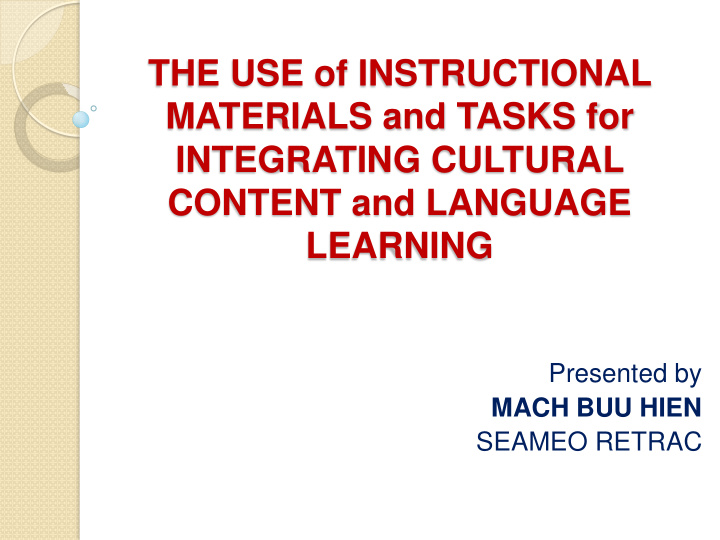



THE USE of INSTRUCTIONAL MATERIALS and TASKS for INTEGRATING CULTURAL CONTENT and LANGUAGE LEARNING Presented by MACH BUU HIEN SEAMEO RETRAC
Objectives This workshop will provide participants with benefits of integrating cultural content in language teaching and learning key concepts and principles of selecting instructional materials to include cultural content. design of tasks from selected teaching materials in their own teaching context
What is culture?
Culture: is “the product of socially and historically situated discourse communities, created & shaped by language” (Kramsch, 1998, p.10) refers to social and cultural contexts, as well as language functions to work as effective facilitators for comprehension (Lantolf, 2000)
Culture: is “a complex system of concepts, attitudes, values, conventions, behaviors, practices, rituals and lifestyles of the people who make up a cultural group…” (Scarino & Kohler, 2003, p.45)
Why should we include cultural content in English Language teaching and learning?
Benefits of integrating culture in language learning Understanding social variables, including social class, age, gender, which may affect the ways in which people speak and behave Becoming more aware of conventional behavior in the target culture and cultural connotations of words and phrases in the target language.
Benefits of integrating culture in language learning Acknowledging various identities of others and respecting them. Developing necessary skills to locate, organize and evaluate information about the target culture Being able to communicate and interact effectively with people from different cultural background
In order to include cultural content, it is crucial to: select appropriate instructional materials use effective methods and strategies design tasks appropriately with students’ language proficiency
WHAT ARE INSTRUCTIONAL MATERIALS?
Video & Posters Audio Books recordings New spapers Films & Brochures & Magazines TV new s Printed or Non-printed items & electronic resources tekhnologic
INSTRUCTIONAL MATERIALS Printed or No- Electronic printed items resources Instructional Process
Instructional Materials Resources PRIMARY RESOURCES SUPPLEMENTARY RESOURCES
How much do you these supplementary resources to design tasks to integrate cultural content in English language teaching and learning? Technological Teaching Cards Authentic devices & Posters materials
Principles of using instructional materials & designing tasks to integrate cultural content 1. Identifying cultural theme 2. Designing tasks to present cultural goals or phenomenon 3. Providing the language input and cultural information for communication
Task 1: Debate and Discussion I AGREE I DISAGREE
Task 1: Debate and Discussion Man should be the leader of the family Doing housework is considered a woman’s duty Women are more emotional, aware of others’ feeling and warm than men Men are smarter than women
Group discussion What is the cultural theme of this task? Gender Stereotypes What are the objectives of this task? Raise learners’ awareness of cultural beliefs in the roles of men and women What language input does the teacher need to provide students with? Expressions & phrases for giving opinions & ideas
Principles of using instructional materials & designing tasks to integrate cultural content Creating authentic classroom environment 4. Focusing on interactional spoken 5. communication Helping learners understand their own and 6. foreign culture and identify similarities and differences Expanding learners’ intercultural knowledge 7.
What types of tasks can be used? Role plays Debates Projects Poster Games Presentation Map Interviews Problem-solving Discussion Simulations
Task 2: Watch a video clip and discuss how to use this authentic material to raise learners’ awareness of conventional behaviors in different culture https://youtu.be/UTE0G9amZNk
Task 3 : Poster Presentation Topic: New Year Celebrations Cultural goals: Identifying similarities and differences in celebrating New Year’s traditions Materials: Video clips about New Year Celebrations in Vietnam and the United States Authentic reading texts about New Year Celebrations in Vietnam and the United States Language knowledge: Comparison Simple Present
References Crawford-Lange, L. M. & Lange, D. L. (2010). Integrating Language and Culture: How to do it. Theory into Practice , 26 (4), 258 -266. Neff, P. & Rucynski Jr. J. (2013). Tasks for Integrating Language and Culture Teaching. English Teaching Forum , (2), 12 - 23 Dema, O. & Moeller A. J. (2012). Teaching culture in the 21 st century language, Faculty Publications : Department of Teaching, Learning and Teacher Education , 76-91. Kramsch, C. (1998). The relationship of language and culture In Language and Culture (pp. 3 - 14). Oxford: Oxford University Press. Lantolf, J. P. (2000). Sociocultural theory and second language learning . Oxford: Oxford University Press. Abbaspour, E., Nia, M. R. & Zare, J. (2012). How to integrate culture in second language education. Journal of Education and Practice , 3 (10), 20 -25.
Recommend
More recommend